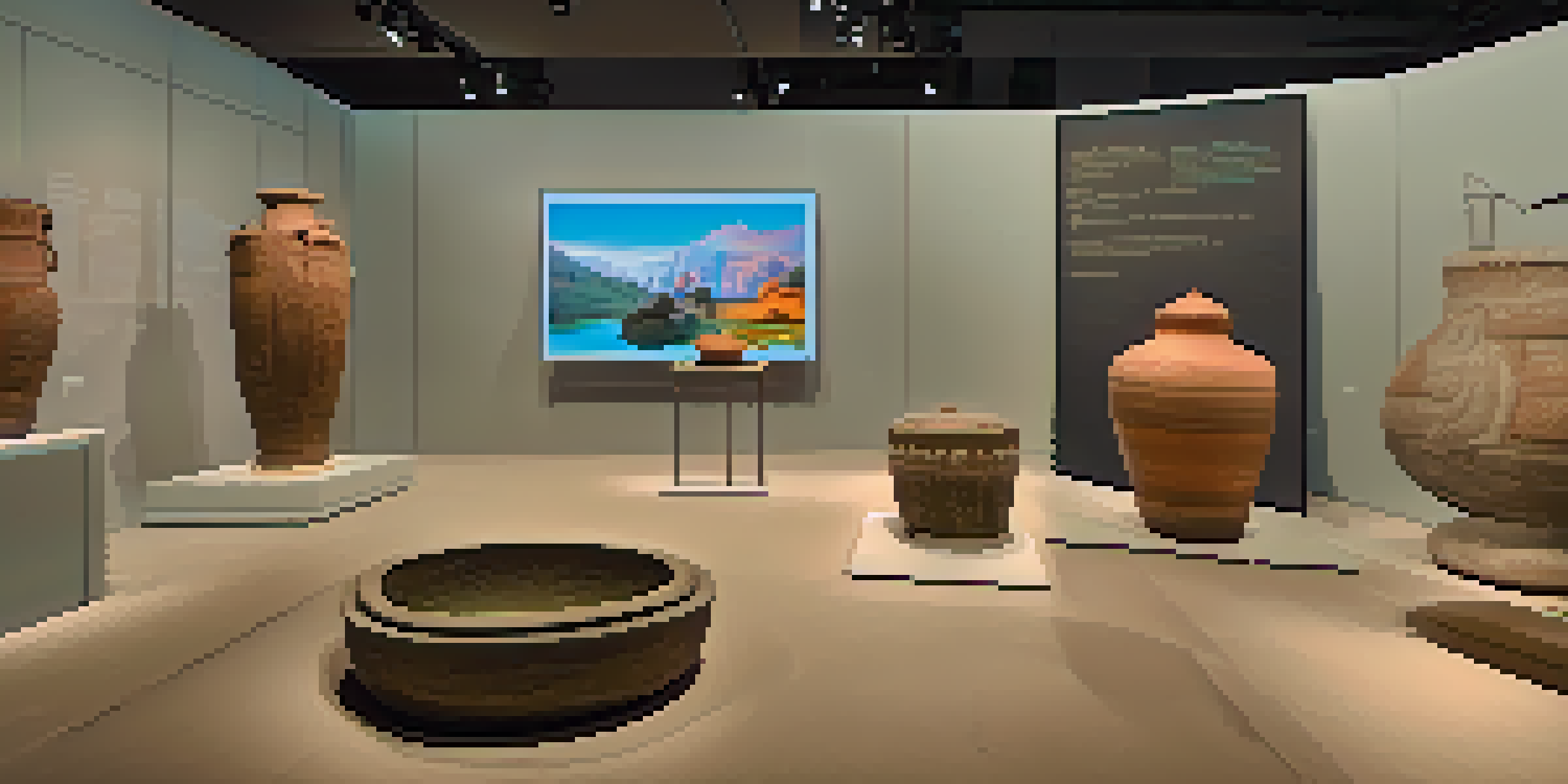Exploring NFTs as a Tool for Historical Artifact Preservation

Understanding NFTs and Their Relevance to Preservation
Non-Fungible Tokens, or NFTs, are unique digital assets verified using blockchain technology. Unlike cryptocurrencies such as Bitcoin, which are interchangeable, NFTs represent ownership of a specific item or piece of content. This uniqueness is crucial when considering the preservation of historical artifacts, as it ensures that every digital representation of an artifact is distinct and traceable.
Digital preservation is not about maintaining copies, but about ensuring that the essence of the original is understood and appreciated.
By leveraging NFTs, museums and collectors can create digital twins of physical artifacts, providing a way to share these items with a broader audience. This digital representation can include high-resolution images, 3D models, and detailed descriptions, making it easier for people to appreciate and learn about historical items. In a world where physical access to artifacts may be limited, NFTs serve as a bridge between the past and the present.
Moreover, NFTs can incorporate smart contracts that outline usage rights and restrictions, ensuring that the integrity of the artifact's representation is maintained. This means that even in the digital realm, the significance and context of historical items can be preserved, creating a richer experience for users.
The Role of NFTs in Protecting Cultural Heritage
Cultural heritage is not just about artifacts; it's about the stories and traditions that accompany them. NFTs can help protect these narratives by allowing for the creation of digital archives that include not only images of artifacts but also the histories behind them. This can be particularly valuable for communities looking to preserve their heritage in the face of globalization and cultural dilution.

By digitizing artifacts and attaching NFTs, communities can ensure that their cultural stories are shared and appreciated globally, rather than being confined to a local museum. This democratization of access helps foster understanding and respect for diverse cultures, which is essential in our interconnected world. It encourages people to engage with cultures different from their own, promoting empathy and learning.
NFTs Enhance Artifact Preservation
By creating unique digital representations of artifacts, NFTs allow museums to share and maintain the integrity of cultural heritage in the digital age.
Additionally, NFTs can facilitate fundraising efforts for heritage preservation projects. When collectors purchase NFTs linked to cultural artifacts, a portion of the proceeds can be directed towards safeguarding the physical items or supporting educational initiatives. This creates a sustainable model for preserving cultural heritage while also engaging the public.
Enhancing Engagement through Interactive Experiences
One of the most exciting aspects of NFTs is their potential to create interactive experiences. Imagine a virtual museum where visitors can explore 3D renderings of artifacts, interact with them, and even participate in live discussions with historians and curators. NFTs can facilitate these experiences, making history more engaging and accessible than ever.
Cultural heritage is the bridge between our past and our future, and technology can help us preserve that bridge.
By incorporating augmented reality (AR) or virtual reality (VR) technologies, NFTs can transport users to different time periods and contexts, allowing them to experience history firsthand. For instance, users could 'visit' an ancient civilization's market by viewing artifacts in their original settings, thus breathing life into static displays. This immersive approach not only captivates audiences but also deepens their understanding of history.
As more institutions explore these interactive possibilities, the educational impact of NFTs will grow. Schools and educational programs could utilize these digital artifacts as teaching tools, fostering a generation that is more connected to history. This level of engagement is something traditional displays often struggle to achieve.
Challenges and Considerations in NFT Implementation
While NFTs offer significant benefits for historical preservation, there are challenges that need addressing. Concerns about the environmental impact of blockchain technology, especially in terms of energy consumption, are at the forefront of this discussion. Institutions must weigh the benefits of NFTs against their carbon footprint and consider more sustainable blockchain options.
Additionally, the legal landscape surrounding NFTs is still evolving. Questions about copyright, ownership, and digital rights management can complicate the creation and sale of NFTs linked to historical artifacts. Museums and collectors need to navigate these complexities to ensure that they are operating within legal frameworks while protecting the interests of artists and communities.
NFTs Foster Cultural Awareness
Digital archives with NFTs help communities preserve and share their cultural narratives globally, promoting understanding and respect for diverse traditions.
Moreover, as with any technology, there's a risk of digital divide. Not everyone has equal access to the internet or the technological literacy required to engage with NFTs. Institutions must strive to make these digital experiences inclusive, ensuring that all audiences can benefit from the preservation efforts.
NFTs as a Revenue Stream for Preservation Efforts
In addition to their role in preservation, NFTs can serve as a unique revenue stream for museums and cultural institutions. By creating and selling NFTs of historical artifacts, these organizations can generate funds that can be reinvested into preservation projects, educational programs, or community outreach initiatives. This self-sustaining model helps secure the future of these important cultural resources.
Collectors are often eager to own a piece of digital history, and NFTs provide a way for them to do so while supporting the institutions that safeguard these artifacts. This symbiotic relationship can lead to innovative collaborations between artists, historians, and collectors. By merging creativity with historical significance, NFTs can attract diverse audiences and generate increased interest in cultural preservation.
Furthermore, the secondary market for NFTs opens up additional opportunities for revenue. Every time an NFT is resold, a percentage of the sale could go back to the original institution, creating ongoing financial support for preservation efforts. This model not only incentivizes the creation of high-quality NFTs but also fosters a community of supporters committed to preserving history.
Real-World Examples of NFTs in Artifact Preservation
Several pioneering projects are already showcasing how NFTs can be effectively used for artifact preservation. For instance, the British Museum has experimented with creating NFTs of select artifacts, allowing users to purchase and own a digital representation of these historic items. This initiative not only raises funds but also generates excitement around the museum's collection, fostering a sense of community among digital collectors.
Another notable example is the collaboration between artists and cultural institutions to create NFTs that highlight endangered artifacts. These projects not only raise awareness about the importance of preservation, but they also generate funds that can be directly allocated to conservation efforts. By combining creative expression with historical significance, these initiatives inspire new conversations about the value of our shared heritage.
NFTs Offer Financial Support
Selling NFTs linked to historical artifacts generates revenue that can be reinvested into preservation projects and educational initiatives.
As more institutions explore the potential of NFTs, we can expect to see an increase in innovative projects that push the boundaries of how we interact with history. These examples serve as a blueprint for others, demonstrating that with creativity and collaboration, NFTs can be a powerful tool in the preservation of our cultural legacy.
The Future of NFTs in Historical Preservation
Looking ahead, the future of NFTs in historical preservation holds immense promise. As technology continues to evolve, we can anticipate more sophisticated ways to link digital representations of artifacts with their physical counterparts. This could include enhanced features such as virtual tours, interactive timelines, and even community-driven content that tells the stories of artifacts from diverse perspectives.
Moreover, the increasing awareness of the importance of preserving cultural heritage will likely drive greater interest in NFTs. As more people recognize the value of historical artifacts, the demand for digital representations will grow, leading to more innovation in the space. This could encourage institutions to invest in their digital strategies and explore partnerships with tech companies and artists.

Ultimately, the integration of NFTs into historical preservation efforts not only safeguards our past but also enriches our understanding of it for future generations. By embracing this technology, we can ensure that the stories and artifacts that shape our world are preserved and celebrated in ways that resonate with people today and in the years to come.